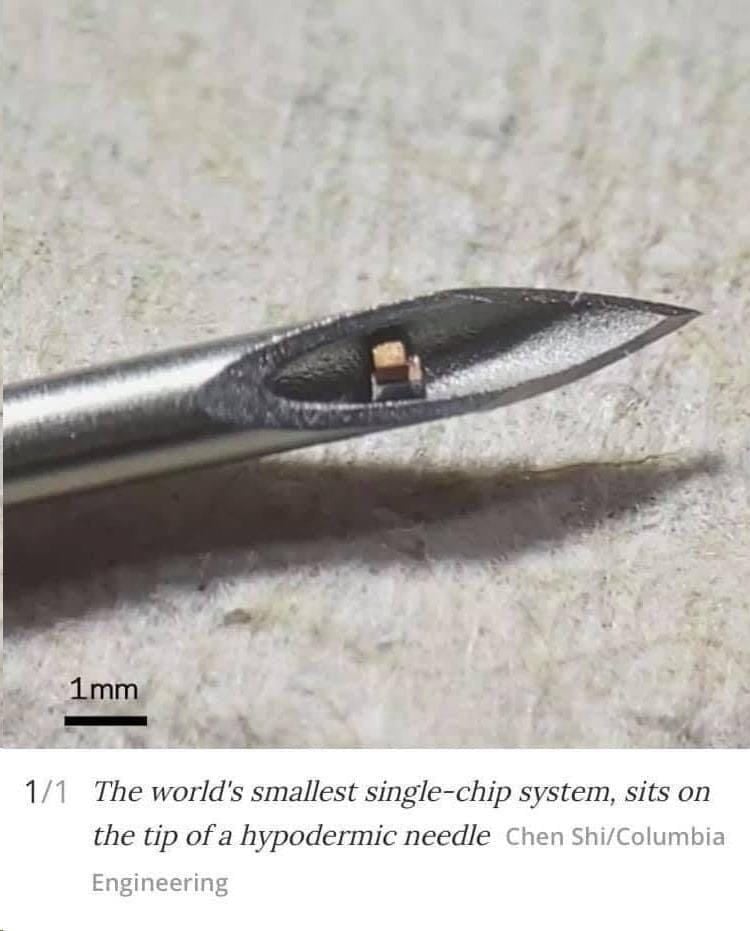Conspiracy theories about chips injected with vaccines are incited by a photo of a microchip made by US scholars and Tiago Costa of TU Delft. “We didn’t see the fuss coming.”
The researchers did not anticipate the fuss their publication would cause on social media. (Photo: Lindsay Mackenzie/WHO)
No we are not involved in a conspiracy to chip the world’s population while injecting vaccines. Really? No, we’re not. You would expect a query like this in a satirical magazine. Yet the Director of Strategic Communications and Media Relations at Columbia University had to answer question like this by Reuters. “This research has nothing to do with Covid-19 and vaccinations,” she told the news organisation. She was asked by Reuters to debunk the rumour that her university was in any way complicit in such a conspiracy.
What prompted all this? A photo of a microchip designed by Columbia University engineers that is doing the rounds among vaccine sceptics. Posts show a picture of the microchip inside the tip of a needle, with captions and comments suggesting a connection with the Covid-19 vaccine. Chipping people would be Bill Gates’ wet dream, many people believe. The comments include: “I heard if a person had the Moderna vaccine, a strong magnet would stick to the arm where the injection was given” and “I’m not taking no bullshit Covid-19 vaccine”.


Is it a hoax? No, not that either. The photo is from a 7 May publication in Science Advances entitled ‘Application of a sub–0.1 mm3 implantable mote for in vivo real-time wireless temperature sensing’. One of the authors is Tiago Costa of the Microelectronics Department (Faculty EEMCS), who until recently worked at Columbia University and is now continuing his research on wireless, miniaturised implantable medical devices at TU Delft.
“We have created a microchip that can be inserted with a needle,” says Costa. “It is the world’s smallest single-chip system, with a volume of less than 0.1 mm3. It uses ultrasound to measure vital signs. Or at least that is the idea. Currently it only measures temperature. But we are working on more diagnostic and therapeutic medical procedures.” The device has been successfully tested on mice.
To date, conventional implanted electronics have been highly volume-inefficient – they generally require multiple chips, packaging, wires, and external transducers, and batteries are often needed for energy storage. A constant trend in electronics has been the tighter integration of electronic components, often moving more and more functions onto the integrated circuit itself.
As big as a grain of salt
The researchers pushed the limits on how small a functioning chip could be made. Measuring just 0.1 mm3, the chip can barely be seen with the naked eye. It is as big as a grain of salt.
The research started several years ago, long before conspiracy theories about chips and vaccines were around. “That the publication came out now, during the height of the vaccination campaigns, is an unfortunate coincidence,” says Costa. He says that neither he nor his colleagues saw the fuss coming. “We were so enthusiastic about our findings, we didn’t give a moment’s thought to how the study would be seen. I guess you can call us naïve,” he says laughing.
But what more grounds are there to debunk the conspiracy theory, aside from the simple fact that it is not clear what motive the researchers would have to make everyone walk on the leash of Bill Gates? For starters, most of the needles used for Covid-19 vaccinations are the relatively thin so-called 25 Gauge needles and the chips don’t fit through these needles. To be injected they need syringes that are a notch bigger.
‘Bioelectronic medicine is booming’
Addressing concerns about the chip being used wirelessly in the future with 5G, Ken Shepard, Professor of Electrical and Biomedical Engineering at Columbia and a researcher on the project, told Reuters that the device does not use electromagnetics. ‘It uses ultrasound, meaning that you have to be interacting with an ultrasound imaging device for the chip to be powered or communicate.’
Do you have a question or comment about this article?
tomas.vandijk@tudelft.nl


Comments are closed.